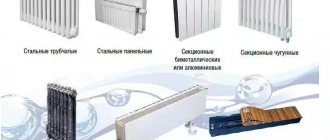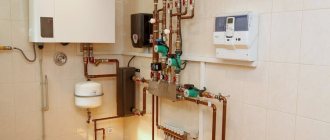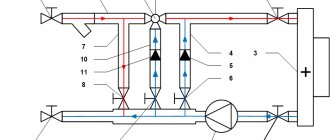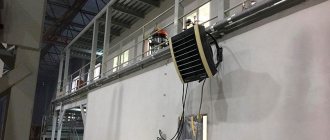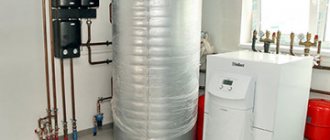Product range overview
Heating devices include:
- heat guns;
- convectors;
- oil and convection radiators;
- infrared heaters;
- thermal curtains.
The listed equipment is selected for specific purposes, taking into account the capabilities and need for maintenance. If the performance of the device does not meet the needs of the room, it will waste energy. Thermal curtains are not used in everyday life. They are relevant in shops, large workshops and industrial facilities. The rest can be found at home, in the country or in the garage. It is for them that the relevant question is how to calculate the power of the heater.
Fan heaters
These are the most affordable devices. They not only produce heat through a heating coil, but also force it into the surrounding air using a built-in fan.
The main advantage is that the room warms up very quickly. At the same time, fan heaters operate with noise generated by the fan blades. In addition, they do not have enough power for large apartments, warehouses, and garages. Thus, this device can only be used at home or at work as an additional heat source.
An overview of models, characteristics and prices is presented in the table.
| model | specifications | price, rub |
| Electrolux EFH/C-5115 | 1400 | |
| Ballu BFH/C-25 | 950 | |
| Timberk TFH T15NTX | 860 | |
| Electrolux EFH/F-8720 | 3800 |
Quick calculation of performance for a heated room
This option is very simple, but does not allow you to calculate the power of the infrared heater. Required:
1. Measure the area (s).
2. Determine the height of the walls (h).
3. Calculate the volume of the room (v) by multiplying the first values.
4. Divide the result of calculating cubic capacity by 30 - a specially defined coefficient number for this type of calculation.
The formula for the determined productivity looks like this: W=s*h/30.
For example: room area - 18 square meters. m, the height of its walls is 2.8 m. We get a cubic capacity of 50.4 cubic meters. m. We divide the volume by 30 and see the result - 1.68 kW is needed to heat the room and keep it warm. In general, we can say that for 10 sq. m (height up to 3 m) you need up to 1 kW/h.
This method will be more accurate if you take into account the location of the rooms in the building. For an office in the northern or corner part, we increase the predicted productivity to 20%.
How to maximize the life of your heater
To take into account the rules of electrical and fire safety, as well as to ensure the maximum service life of the purchased device, you need to follow a few simple tips:
- You cannot turn on 2 heaters at the same time in one socket (as well as in 1 surge protector) (or 1 heater and an energy-intensive appliance - a coffee pot, kettle, iron, etc.).
- If there is a suspicion of a malfunction, use of the device is strictly prohibited.
- You should also not leave the heater on unattended. It is better to heat it in the evening and turn off the device at night. In addition, if it heats for several hours in a row, you can wake up with a feeling of heaviness in your head.
- It is unacceptable to cover the heater with a cloth, dry wet objects on it (it is better to use a central heating radiator for this), or place it under a window from which curtains will hang onto the surface of the device.
- Heaters should always be cleaned of dust by removing it with a slightly damp microfiber cloth. Then wipe it dry, and only after that you can turn it on.
NOTE. Before using the model, you should always pay attention to the instructions - in some cases, devices have their own nuances (for example, the maximum continuous operation periods may differ, etc.).
How to calculate the power of electric heaters for a garage or warehouse
This algorithm is suitable for unheated utility rooms. It takes into account volume, thermal insulation of walls, temperature differences.
1. Determine the cubic capacity of the room: v=s*h.
2. Calculate the temperature difference (? T). We subtract the street readings from the expected temperature.
3. We multiply the resulting numbers together with the thermal insulation coefficient (k) and get the required number of kilocalories per hour needed for heating and maintaining heat.
4. Divide everything by 860. The result will be the required kilowatts.
The formula that allows you to calculate the power of electric heaters for garages and other utility rooms: W=k*v*?T/860.
The thermal insulation coefficient is different:
- structures without thermal insulation – 4.0;
- simple buildings made of wood or corrugated board - from 3.0;
- single brickwork with a simple window and roof structure - from 2.0;
- ordinary buildings (Soviet multi-storey buildings, old buildings) – from 1.0;
- modern buildings or with additional insulation - from 0.6.
As an example, we suggest calculating the predicted power of electric heaters for a garage with single brick masonry and a simple slate roof. Let's say its area is 24 square meters. m, from floor to ceiling - 3 m, outside temperature - -3 degrees, we want to get heat +15. We calculate using the formula:
W=2*24*3*(15 - (-3)/860=3 kW, or W=2.9*24*3*(15 - (-3)/860=4.4 kW.
Conclusion: for heating under the specified conditions, a performance of 3 to 4.4 kilowatts is required.
We are starting a short series of articles devoted to calculating the power of heaters for apartments and private houses. Let's start with heating radiators. Why is it important? The answer is simple: the house should be warm and comfortable. Even in the most severe frosts, you don’t wear felt boots and a hat indoors. And ideally, never buy electric heaters. On the other hand, heat is also not an option. Forcibly turning off radiators will not help save on utility bills, and regular ventilation of rooms is not always possible. Especially if there are children in the house.
Therefore, let's find out how many radiator sections are needed for a comfortable life. And how to get this figure.
The simplest calculation
If you are building a house yourself and are not very versed in heating issues, you will easily fall for the bait of construction store consultants. Very often you can hear that the calculation of radiator sections is the most basic:
100 W of power per 1 square meter
Or another option:
2 battery sections per 1 square meter
It would seem that everything is clear and understandable. But it's all about the nuances. Such a primitive formula does not take into account the features of the room, the height of the ceilings, the number of doors and windows, the presence of thermal insulation and balconies. Everything that affects heat loss and without which the heating system will not work efficiently and - what is important - economically.
What information is needed
Before you start calculating the heater’s power, collect a “history”.
This is all the information about the specific room where it is planned to install heating devices.
- Climate of the area and air temperature during the heating season. The choice of heaters, calculation of their quantity and power will be very different in the middle zone and northern part of our country.
- Location of the room and specifically the windows (north, south, east, west)
- Purpose of the room: living room, children's room, kitchen, utility room, attic.
- Wall material and thickness.
- The number of windows, doors, their configuration (regular or French windows), the presence and type of balconies (loggia, attic).
- Ventilation - natural and forced.
Then you need to decide on the material of future radiators. Usually this happens at the stage of the design project, but if we are talking about an apartment with already installed appliances, and you want to change them, the decision to replace them is made at the first stages of the renovation. The number of radiator sections per room depends on their type:
- Steel ones have a power of 100-150 W per section
- Cast iron - 160 W
- Bimetallic - 170-180 W
- Aluminum - the most powerful, 180-200 W.
And one more parameter. The above power values for radiators of different materials are ideal. The manufacturer indicates them in the accompanying documentation, but they are slightly divorced from reality. The power of the heating radiator section is affected by the coolant temperature. If you know it, the calculation will be more accurate. The so-called DT parameter takes into account the temperature of the coolant at the inlet and outlet. The maximum power of the radiator section is achieved with the 90/70 parameter. But such temperatures are rare for the Russian heating system. The standard figure is 67-75/53-55 °C.
Calculation by area
This is the same simple calculation that we talked about above, but with clarifications. Suitable for rooms with normal ceiling heights, no more than 3 meters.
Formula:
100 W*S/N,
where S is the area of the room (m²) and N is the power of the radiator section
Example:
100*15/150=10
10 radiator sections will be needed to heat a 15-meter living room.
To get a more realistic and accurate figure add:
- +20% for a balcony in the room or a bay window;
- +30% for two windows, two external walls and a corner location of the apartment;
- +10-15% for screens for radiators that completely hide them;
- + 15% is always added in case of abnormal cold weather.
The calculation formula is also clarified by the climate coefficient. It is relevant for the northern and southern regions, where the air temperature differs significantly from central Russia. The coefficient for the north is 1.6. For the south - 0.9.
Calculation by room volume
It is carried out for rooms with high ceilings and non-standard configurations. It is based on the fact that heating 1 cubic meter of room requires 40 W of thermal power.
Formula:
V*40W/N,
Where V is the volume of the room m3, and N is the power of the radiator section
Calculation example:
104 (width 6.5*length 5*height 3.2)*40/150 = 27.
Those. 27 sections will be needed for comfortable heating of a room with a volume of 104 m3.
Detailed calculation of the number of heating radiator sections
This formula has a lot of clarifications. It may be suitable for apartments, but for this you need to know all the intricacies of building a specific multi-story building. Nevertheless, the owner of the cottage has the privilege to directly participate in the construction of the facility, control the purchase of building materials and finishing, and also receive comprehensive information about each material used.
Formula
100W *S *K1 *K2 *K3 *K4 *K5 *K6 * K7,
where S is the area of the room (m²), and the set K is coefficients that will help detail the calculation.
K1 - window glazing: coefficient for double glazing, 1.0 for double glazing, 0.85 for triple glazing.
K2 - coefficient of thermal insulation of walls: 1.27 low, 1.0 single-layer, 0.85 two-layer.
K3 - window to floor area ratio: 0.8 (10%); 0.9; 1.0; 1.1; 1.2 (50%).
K4 - coefficient of the lowest temperature in winter: 0.7 (10°C); 0.9 (15°C); 1.1 (20°C); 1.3 (25°C); 1.5 (30°C).
K5 - coefficient of the number of external walls: one 1.1; two 1.2; three 1.3; four 1.4.
K6 - room type: attic coefficient 1; warm attic - 0.9; warm ground floor - 0.8
K7 - ceiling height: coefficient 1 for a height of 2.5 meters; 1.05 for 3 m; 1.1 for 3.5 m; 1.15 for 4 m; 1.2 for 4.5 m.
The following will help you save on the number of radiator sections without losing heat:
- High-quality thermal insulation
- Insulation of doors and slopes
- Glazed and insulated loggias and balconies
- Heating appliances operating in the kitchen or dining area: stoves, ovens, grills, etc. This is why it is so important to consider the type of room for installing and calculating radiators.
Infrared heaters: how to calculate their power?
Such a device heats objects and people, their heat further spreads throughout the room. Therefore, the required performance is determined differently. You can calculate the power of an infrared heater in space as follows: depending on the model, per 1 sq. m, costs of up to 0.1 kilowatt are expected. This number can start from 0.01 kW.
Pay attention to the factory specifications to understand how to calculate the heater's power. Modern infrared heat producers provide significant savings in unheated rooms. But their efficiency is on average 2 times less. That is, per 1 sq. m costs can reach 0.2 kilowatts.
Does the heater burn oxygen?
There is a widespread belief that the heater burns oxygen, which is why many people get headaches after using it for long periods of time. In this regard, many manufacturers or stores specifically inform customers that their models do not burn air.
In fact, not a single heater model burns air. Combustion, which is necessarily accompanied by the formation of fire, is associated with the process of wasting oxygen to burn fuel. However, heaters do not burn the air, but heat and dry it.
Headaches can be associated with too long continuous use of the device, due to which the air heats up too much and becomes stuffy - almost the same effect is observed if you do not ventilate the apartment for a long time in winter. In addition, dust particles may fall on the heating element and burn - in this case, oxygen is actually burned, but in a very small amount.
From the point of view of comfort, in this case, oil heaters win , which can be easily wiped with a damp cloth before turning on, brushing away all the dust that will not burn during operation of the device.
The following discusses the advantages and disadvantages of different types of heaters, as well as an overview of specific models, their technical characteristics and average prices.
Calculation of different types of radiators
If you are going to install sectional radiators of a standard size (with an axial distance of 50 cm in height) and have already chosen the material, model and desired size, there should not be any difficulties in calculating their number. Most reputable companies that supply good heating equipment have on their website the technical data of all modifications, including thermal power. If it is not the power that is indicated, but the coolant flow rate, then it is easy to convert to power: the coolant flow rate of 1 l/min is approximately equal to the power of 1 kW (1000 W).
The axial distance of the radiator is determined by the height between the centers of the holes for coolant supply/discharge
To make life easier for customers, many websites install a specially designed calculator program. Then the calculation of heating radiator sections comes down to entering data on your premises in the appropriate fields. And at the output you have the finished result: the number of sections of this model in pieces.
The axial distance is determined between the centers of the coolant holes
But if you’re just evaluating possible options, then it’s worth considering that radiators of the same size made of different materials have different thermal power. The method for calculating the number of sections of bimetallic radiators is no different from calculating aluminum, steel or cast iron. Only the thermal power of one section can be different.
To make it easier to calculate, there are averaged data that you can use as a guide. For one radiator section with an axial distance of 50 cm, the following power values are accepted:
- aluminum - 190W
- bimetallic - 185W
- cast iron - 145W.
If you are just figuring out which material to choose, you can use this data. For clarity, we present the simplest calculation of sections of bimetallic heating radiators, which takes into account only the area of the room.
When determining the number of heating devices made of bimetal of a standard size (center distance 50 cm), it is assumed that one section can heat 1.8 m 2 of area. Then for a room of 16 m 2 you need: 16 m 2 /1.8 m 2 = 8.88 pcs. Let's round up - we need 9 sections.
We calculate similarly for cast iron or steel bars. All you need is the following rules:
- bimetallic radiator - 1.8m2
- aluminum - 1.9-2.0 m 2
- cast iron - 1.4-1.5 m 2.
This data is for sections with an interaxial distance of 50 cm. Today, there are models on sale with very different heights: from 60cm to 20cm and even lower. Models 20cm and below are called curb. Naturally, their power differs from the specified standard, and if you plan to use a “non-standard”, you will have to make adjustments. Either look for passport data, or do the math yourself. We proceed from the fact that the heat transfer of a heating device directly depends on its area. As the height decreases, the area of the device decreases, and, therefore, the power decreases proportionally. That is, you need to find the ratio of the heights of the selected radiator with the standard, and then use this coefficient to correct the result.
Calculation of cast iron heating radiators. Can be calculated by area or volume of the room
For clarity, we will calculate aluminum radiators by area. The room is the same: 16m 2. We count the number of sections of standard size: 16m 2 /2m 2 = 8 pieces. But we want to use small sections with a height of 40 cm. We find the ratio of radiators of the selected size to standard ones: 50cm/40cm=1.25. And now we adjust the quantity: 8pcs * 1.25 = 10pcs.
Which heater consumes less electricity for a summer house and other homes?
Based on many experiments, we can single out one type that consumes less electricity. Such a device is a convector. The operating principle is similar to an oil radiator, but is distinguished by its safety and modernity.
Air circulates through the heating element, which is located in the convector. Thus, heat exchange occurs. The convector can be left on for a long time unattended, as it is one of the safest devices.
Such heating equipment is ideal for a country house. It does not dry the air, and the heating temperature cannot exceed 60 °C. After turning on the convector, the room will begin to heat up after 20 minutes. It consumes 25% less electricity than other heating devices.
The convector is considered the most economical for the home.
Why do we need ceiling heights when calculating?
So, let's look at a certain “standard” option - a house with an area of 100 square meters.
In calculations based on the area of the house, we rely on the value “1 kW of boiler thermal power for every 10 square meters of area” and find that we need a 10 kW boiler to heat a house with an area of 100 m2. Now let's pay attention to the height of the ceilings in the rooms. They can be 2.20, 2.50 and, for example, 3.0 meters
In the first option, the volume of the premises will be 220 cubic meters, in the second – 250 and in the third – 300 m3.
Any heat generator that operates in your home, with the exception of IR panels and the like, heats the air inside the room. Thanks to convection, warm air mixes with cold air and ensures heat transfer throughout the entire volume. As a result, any boiler or furnace heats the air in the house. And air is measured precisely in volumetric quantities, that is, in cubic meters.
In the first case, we will need to heat 220 cubic meters of air in the interior of the house, and in the latter - 300 cubic meters. It is logical to assume that when heating 300 cubic meters of air, almost 1.5 times more heat will be required than when heating 220 cubic meters.
That is, with the same area of premises in the first case, you can use a boiler almost 1.5 times less powerful than in the latter.
Calculation of cooling (heating) time in Excel.
The calculation algorithm is based on the Newton-Richmann law and on theoretical and practical studies of the regular thermal regime by Soviet scientists G.M. Kondratyev (“Regular thermal regime”, Moscow, 1954) and M.A. Mikheev (“Fundamentals of Heat Transfer”, Moscow, 1977).
For example, we chose to calculate the heating time to +22 °C in a room with an air temperature of +24 °C of an aluminum beer can with water pre-cooled to +13 °C.
Initial data:
The parameters required to calculate the cooling (heating) time are 12 (see screenshot).
Approximate information about the values of the heat transfer coefficient α is given in the note to cell D3.
The thermophysical characteristics of the body material λ , a , ρ , c can be easily found in reference books or upon request on the Internet. In our example, these are water parameters.
In principle, to perform the calculation it is enough to know the values of any of the pairs of characteristics: λ , a or ρ , c . But to be able to perform the check and minimize the likelihood of an error, I recommend filling in all 4 cells with values.
We enter the values of the initial data into the corresponding cells of the Excel sheet and read the result: heating water from +13 °C to +22 °C in the calm air of a room with a constant temperature of +24 °C will last 3 hours 25 minutes.
For reference, at the very end of the table, the heating time is calculated without taking into account the shape of the body - 3 hours 3 minutes.
Calculation algorithm:
- 13.1. F =2 · H · L +2 · B · L +2 · H · B – for a parallelepiped;
- 13.2. F =π · D · L +2 · π · D 2 /4 – for a cylinder;
- 13.3. F = π · D 2 – for the ball.
- 14.1. V = H · L · B – for a parallelepiped;
- 14.2. V = L · π · D 2 /4 – for a cylinder;
- 14.3. V = π · D 3 /6 – for the ball.
- 15. G = ρ V _
- 16.1 K =(( π / H )2 + ( π / L )2 + ( π / B )2)-1 – for a parallelepiped;
- 16.2 K =((2.405 /( D /2))2 + ( π / L )2)-1 – for the cylinder;
- 16.3 K =( ( D /2)/ π )2 – for the ball.
- 17. m ∞ = a / K
- 18. Bi = α K F / ( λ V ) _ _
- 19. Ψ=(1+1.44 Bi + Bi 2 ) -0.5
- 20. M= Ψ Bi
- 21. m αλ = M m ∞ _
- 22. m cρ = Ψ α F / ( c ρ V ) _ _ _
- 23. Δ = ABS (1-m αλ / m cρ ) 100
- 24. t =(LN (ABS (tc-t1)) -LN (ABS (tc-t2))/m αλ
- 25. t N =(LN (ABS (tc-t1)) -LN (ABS (tc-t2))) c ρ V /( α F)
How much does an oil heater consume per day?
This type of heater burns a small amount of oxygen and consumes little electricity. In addition, they are not as fire hazardous as other devices.
The disadvantages are high cost and heavy weight. On average, an oil heater consumes 750W per hour. More powerful heaters consume about 1 kW. But you can find devices with less power.
Since the device operates several hours a day, electricity consumption is significantly less.
Oil heater
The higher the power of the device, the more electricity it consumes. When the device is turned off and in rest mode, it does not waste energy. Despite some disadvantages, there are more advantages. That is why it is popular among residents of private houses. You can calculate the amount of electricity consumed after 1 month of using the device.


